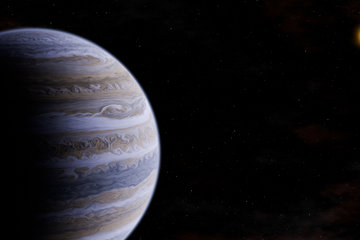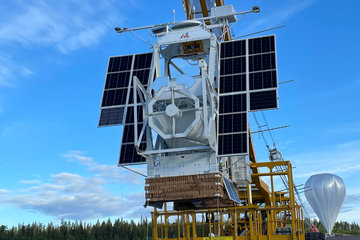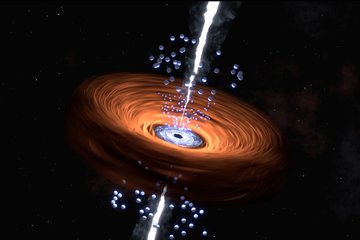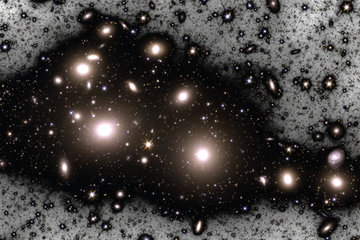Searching for clues in a fly-by
The BepiColombo space probe measures carbon ions escaping from the atmosphere of Venus and thus helps to decipher the special development of Venus
During its flyby of Venus, the European-Japanese space probe Bepi Colombo for the first time found carbon ions escaping from the planet's atmosphere into space in a previously unexplored region on the night side of the planet. Investigations of the ion distribution help to understand which processes have shaped the atmosphere of our neighboring planet and why it differs so greatly from Earth’s gas envelope. The idea for the new measurements was inspired by a rare cosmic event that occurred 25 years ago - and brought a whiff of Venus to Earth.

In order to slow down on its way to Mercury, Bepi Colombo passed Venus for the second time on August 10, 2021. Equipped with scientific instruments superior to those of older Venus travelers, the space probe flew through a previously unexplored region on the night side of the planet. This type of “flying visit” not only offers the scientific and technical teams of the individual instruments on board the opportunity to test their instruments under real space conditions. The data often also contains valuable scientific findings. For MPPE, however, optimal measurement conditions were not to be expected. The instrument should have remained switched off.
Researchers from the MPPE team nevertheless insisted on determining the distribution of charged and uncharged particles in the planet's environment as best they could during the flyby. "For more than two decades, we have been driven by measurements from the SOHO space probe," explains Markus Fränz, scientist at the Max Planck Institute for Solar System Research. In 1996, SOHO, the Solar and Heliospheric Observatory of ESA and NASA, discovered carbon ions from Venus near Earth. At that time, Earth lay exactly in the solar slipstream of Venus. Under these rare conditions, ions from Venus' night-side environment could penetrate far into space and even reach Earth. On site at Venus, the detection of carbon ions at a greater distance from the planet had not yet been successful. "We were very keen on investigating this further," continues Fränz.

No water, weak magnetic field
The researchers are particularly interested in why Venus and Earth have taken such different evolutionary paths since their formation and offer completely different conditions today. While our home planet became a life-friendly world with plenty of water and an oxygen-rich atmosphere, Venus has largely lost its former water. The high proportion of carbon dioxide in its atmosphere also favors an extreme greenhouse effect and thus generates high surface temperatures of more than 450 degrees Celsius on average. "The processes that are still taking place in the Venusian ionosphere today provide important clues as to how the planet has evolved," says Norbert Krupp, scientist at the Max Planck Institute for Solar System Research.
Unlike Earth, Venus does not itself generate a magnetic field in its interior that binds particles from the atmosphere to the planet. The charged particles of the solar wind, the constant stream of particles from the Sun, only induce a weak magnetic field. Light or fast particles can therefore easily leave the planet's sphere of influence. Heavy ions and molecules, on the other hand, such as carbon ions, should actually remain bound - just like on Earth or Mars.
Higher resolution than its predecessor

During the flyby, it was now possible for the first time to confirm the SOHO measurements from 1996 in close proximity to Venus. "Apparently, carbon ions in the Venusian magnetosphere receive enough energy to escape into space," summarizes Harald Krüger, also scientist at the Max Planck Institute for Solar System Research. This is shown by measurements from the MPPE sensors. Comparable investigations performed by older Venus probes such as Venus Express had not been able to reliably distinguish carbon ions from other ions and molecules with similar masses. In addition, Venus Express passed through the Venus’ magnetosphere too close to the surface, a rather unfavourable area to search for the ejected ions. Only BepiColombo’s instruments now offer the necessary mass resolution.
"There is obviously a complex atmospheric chemistry at work in the atmosphere of Venus that is fundamentally different from that of Earth and Mars," says Fränz. In addition to the carbon ions, the researchers also found around three times as many escaping oxygen ions. The excess of oxygen ions points to water molecules or ions as a possible source.
Flight path through unexplored area
During the flyby, BepiColombo approached Venus from the night side. There, the Venusian magnetosphere is typically elongated and extends far out into space. The current measurements were taken at a distance of around 36,000 kilometers from the planet. No other space mission had ever crossed this region before: the trajectories of ESA's Venus Express space probe, which orbited the planet for around eight years from 2006, passed closer to the planet’s surface on the night side; NASA's Pioneer Venus Orbiter, which was launched in the late 1970s, kept a greater distance.
The scientists hope to gain further insights into the chemical reactions that take place in the atmosphere of Venus from future visitors to the planet. On its very elliptical orbit around the Sun, ESA‘s space probe Solar Orbiter will pass the planet several times over the next few years; ESA’s Venus mission EnVision is expected to be launched into space in the 1930s.
Additional Information
The Max Planck Institute for Solar System Research is involved in a total of four instruments of the BepiColombo mission. Scientists and engineers at the Institute have developed and built components of the MSA (Mass Spectrum Analyzer) sensor for the MPPE (Mercury Plasma Particle Experiment) instrument package. The institute has also been involved in older Venus missions. The Institute contributed the instrument ASPERA-4 (Analyzer of Space Plasmas and Energetic Atoms) on board ESA’s space probe Venus Express. The MPS is currently developing components of the VenSpec spectrometer for ESA’s future mission EnVision to Venus.














